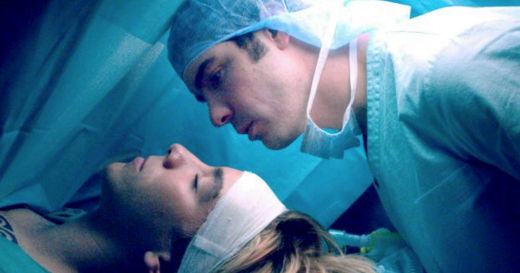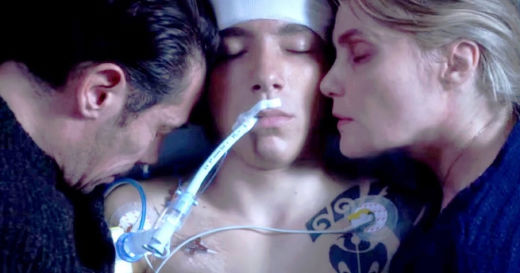A review of the film Heal the Living weaves a rich tapestry of the emotions and relationships at the edge of life and technology.
Author: David Zigmond
A recent film Heal the Living (directed by Katell Quillévérré, 2016) weaves a rich tapestry. Life’s vicissitudes, human paradox and interconnectedness – all are here: holism at its most raw and tender.
Spoiler alert: This article describes much of the content of the film.
Heal the Living is a masterwork of humane and tender intelligence. What is it? One cinema’s publicity one-lines the film as ‘The intersecting lives of teens on a surfing trip, a woman with a weak heart, and two teams of doctors and medical experts.’ Well, those are the elements, sort of.
To flesh out the plot a little, we find that many lives intersect around the central act, which is a miraculously disturbing relaying of life: a heart transplant. Simon is a joyous, boisterous, libidinal seventeen-year-old. Claire is about thirty years older, separated, and slowly dying from an incurably degenerating heart: a dilating cardiomyopathy. Her two sons are similar in age to Simon, and with poignant warmth she both shields them from, and prepares them for, her likely death. Only a transplant can save her. She knows this; they sense it.
Simon is killed suddenly in a traffic accident: his brain mortally damaged, the rest of him largely uninjured. Only external machines, and the machines’ attendants, keep him alive. His brain-death makes him an ideal organ donor.

A life is wiped out and a family shattered; yet through this another life is saved, a family can continue. Life as a relay: all our lives will pass, but in our passing we pass on something that lives beyond us...
But such Olympian grace does not come easily, if at all.
The stricken Simon’s parents, Marianne and Vincent, live separately in ambiguous interdependence but are now thrown together in their shocking grief. In the neon-lit ICU their immobile but well-perfused son lies, apparently asleep, between them. But the illusion of somnolent life is maintained only by snaking conduit tubes and the soft hissing clump of the ventilator.
The ICU Consultant, we sense, is sensitive to the frailty of humankind – not just our bodies but our loving attachments and family life. We first see him, Dr Pierre Révol, gently carrying his limply tired daughter to a front door – the home of her mother and his ex-wife, we suppose. As he looks through the door we see a look of vigilant sadness, of protective regret. As he drives to work he cheers himself with hip-hop music from his car audio system, tapping his fingers rhythmically to stimulate and distract himself.
Now Dr Révol is telling Marianne and Vincent that Simon, despite appearances, is, in fact, dead. We see the light dwindle and dull in Marianne’s eyes, her gaze of numbed incomprehension morphing to primitive and wordless pain. Vincent, sitting beside her, instead resorts to fight or flight. His eyes flash angrily and he argues with the doctor about the facts, the hopeless prognosis: ‘it cannot be true’. Then, realising ineluctable events, he wants to flee the doctor, this harbinger of death. Vincent then turns inwards, to berate and blame himself for tragedy, his residual guilt for his self-perceived paternal shortcomings. He sobs and collapses into Marianne’s loving embrace: whatever their past hurts and disappointments, this estranged couple now find loving comfort in their shared grief. There is a glow in this darkness.
Meanwhile, the slowly dying Claire is talking to a cardiac surgeon about joining the waiting list for a heart transplant. ‘It is your only hope’, she is told. But Claire is hesitant with ambivalence: she is unsure of receiving the heart of a dead person, of continuing her life astride another’s tragedy. She seems, already, afraid of her future inhabitation by others’ ghosts.
In two cities, different medical teams gaze at data and scans telling them of the decline or viability of the organ parts of their respective patients: the donor and the recipient. Between colleagues there is business-like exchange, both fuelled and shadowed by the gravity of the task. They lighten their burden with convivial banter, yet sometimes their fatigued tension turns momentarily fractious and critical. The camera catches the human vulnerability of these healer-heroes, how they, too, need healing and respite.
How do they do this? The transplant coordinating doctor slumps wearily at his computer and resorts to viewing on You Tube a much-cherished African finch whose colour and song infuses him with a sense of wider life; an emotionally exhausted nurse enters a lift alone and briefly enters an erotic reverie – enfolded and interwoven with the libidinal breath, pulse and life of another.
These medics are obviously working in the most hi tech and high drama areas in healthcare, but the film shows how they deliver this despite, or maybe because of, their own wounds, struggles or incompleteness. The word ‘empathy’ is never used, but we witness this fleetingly and often: Dr Révol wordlessly understanding and gently containing Vincent’s inchoate and guilt-laden anger; the transplant coordinator cleaning and dignifying Simon’s body with meticulous and tender care, after his heart has been removed. Such images last only a few seconds, yet each carry a profound message about life’s value and the sacred mystery of its passing.
Such is the subtle, almost seamless, meditative power of this film. In an early scene Simon and two teenage friends are surfing in an increasingly powerful rolling, roiling sea. Sometimes they can be powered astride this illimitable elemental force, at others they are tossed about helplessly in thrall to an implacable Nature. They are riding the cusp between mastery and powerlessness, the transient and the eternal, the surge of life and its surrender. Playing on this cusp they feel, for a short while, at one with the source of all life. They exhilarate in being so fully alive.
Immediately before Simon’s fatal accident we see the three friends driving away from the sea, tired and satiated from their surfing. While Simon falls asleep with one friend, the other steers their van along a long twilit road. He drifts into a reverie where the sea and sky become one.
We hear a crash and the screen goes black. Simon’s life is ended.
At the end of Heal the Living we see Claire regaining consciousness after her long transplant procedure. While she has been unconscious we have seen deep inside her chest cavity to watch the surgeon’s meticulous and knowledgeable dexterity. We have seen, too, how the various biotechnicians tend the machines to oxygenate and propel her blood from outside her body. Like Simon she, too – for a while – has only such biotechnology to keep her alive.
When Claire opens her eyes, her gaze is initially bleary, blinking and blurred, unfocused and uncomprehending – like a newborn. As she reconfigures her world, she smiles with joy at seeing the world and being alive.
This is Heal the Living’s last image.
I have been reading, writing and talking bout holistic medicine for more than forty years, pursuing its possibilities and meaning with a graphic, analytic and narratived language of words. But this film – these images – brought an unprecedently, subtle enlivenment to my long explorations: a benign haunting that continues long after I watched Claire’s awakening smile.
We, too, must awaken frequently and see the world afresh if we are to be infused with any spirit or philosophy of holism.
Words can help us, but there is so much else.

Many articles exploring similar themes are available via David Zigmond’s blog here. David would be pleased to receive your feedback.
The publisher is the Centre for Welfare Reform.
Hi Tech With Many Human Hearts © David Zigmond 2017.
All Rights Reserved. No part of this paper may be reproduced in any form without permission from the publisher except for the quotation of brief passages in reviews.